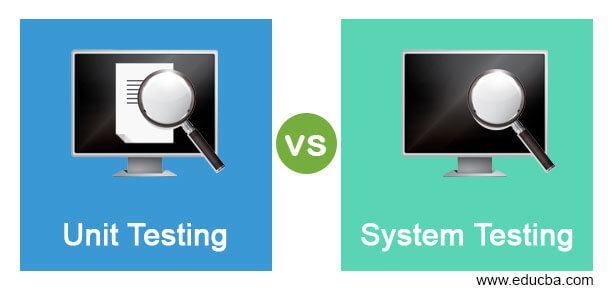
Introduction to Unit Testing vs System Testing
In unit testing, the tester test the single unit of the system at a time, whereas in system testing, the tester test the multiple modules at a time. Unit testing is also known as white-box testing, whereas System testing is also known as black-box testing. In this article, we are going to discuss the difference between unit testing and system testing.
Unit Testing:
In unit testing, small components of the software are tested in isolation. It uses stub and driver. A driver is used to generate method calls for the components being tested. A component that utilizes the method is immitted as the stub. It is a virtual part of the testing, which ensures faster development, documentation, sound design, debugging, and feedback mechanism. Steps in unit testing are carried out for multiple components simultaneously. Stub executes the written imitation of the task of the component. It displays the message after the execution of the component. Also, read about unit testing vs integration testing.
System Testing:
System testing tests the behavior of the system. Based on the requirements, test cases are designed and executed accordingly. System testing is categorized into various types, such as recovery testing, security testing, stress testing, and performance testing.
- Recovery testing: It makes the software decline in several ways for checking the recovery process of the system.
- Security testing: It verifies the security mechanism and ensures that the system is protected from any other malware or attack.
- Stress testing: It checks the stress of the system under a certain load. It requires resources like volume, frequency, and quantity.
- Performance testing: It checks the performance of the software in relevance to the whole system.
Head to Head Comparison Between Unit Testing vs System Testing (Infographics)
Below are the top 11 differences between Unit Testing vs System Testing:
Comparison Table of Unit Testing vs System Testing
|
Unit testing |
System testing |
| In unit testing, the testing team test only a single unit of the system at a time, not the integrated version of the system. | In system testing, the testing team treats each module as a separate target for testing and integrates these modules one by one after testing is completed on them. |
| Unit testing is also known as white-box testing. | System testing is also known as black-box testing. |
| To perform unit testing, a single module testing approach is used. | To perform system testing, bottom-up approach testing and top-down approach testing are used. |
| As unit testing tests a single unit at a time, it does not support parallel testing. | As system testing tests multiple units in parallel, it supports parallel testing. |
| The performance of unit testing is higher than the system testing. | performance of the system testing is lower than the Unit testing. |
| In unit testing, it is easy to find the defects. | In system testing, it is difficult to find the defects. |
| It requires less resources. | It requires more resources. |
| The cost of unit testing is less as compared to system testing. | The cost of system testing is high as compared to unit testing. |
| The goal of unit testing is to validate the functional requirements. | The goal of system testing is to check the system validation. |
| It is performed by developers. | It is performed by both developers and testers. |
| In unit testing, visibility of the code details is provided. | In system testing, visibility of the code details are not provided. |
Key Differences between Unit Testing vs System Testing
Unit testing works on the module specification, whereas system testing works on the integrated requirement specification for the software as well as hardware.
In unit testing, one single module is considered at a time, whereas in system testing, entire systems Functionalities are taken into consideration.
In unit testing, code details are visible to the tester, while in the case of system testing, it is not visible to the tester. The reason behind this is that unit testing can be carried out by the developers, but system testing is a bigger task in which both tester and developer are two different individuals who take part to perform the different operations.
Unit testing uses scaffolding techniques, whereas in system testing tester does not use scaffolding techniques.
To perform unit testing, a single module testing approach is used, whereas to perform system testing, bottom-up approach testing, and top-down approach testing are used.
Unit testing does not support parallel testing, while system testing supports parallel testing.
Unit testing requires less resources, whereas system testing requires more resources.
Performance of unit testing is higher than the system testing, whereas the performance of system testing is low as compared to unit testing.
Unit testing concentrates on functional requirements, whereas system testing concentrates on system validation.
Unit testing is less expensive than system testing, whereas system testing is expensive than unit testing.
Conclusion
Here in this article, we have discussed the possible differences between unit testing and system testing with the help of a comparison table and key differences. I hope you enjoyed the article.
Recommended Articles
This is a guide to Unit Testing vs System Testing. Here we discuss the Unit Testing vs System Testing key differences with infographics and comparison table, respectively. You may also have a look at the following articles to learn more –

